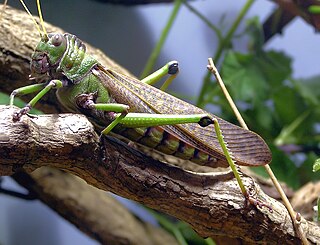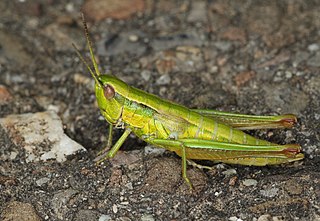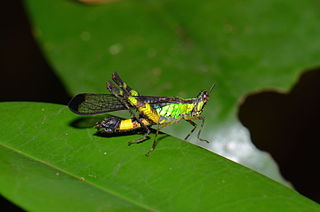
Bandwings, or band-winged grasshoppers, are the subfamily Oedipodinae of grasshoppers classified under the family Acrididae. They have a worldwide distribution and were originally elevated to full family status as the Oedipodidae. Many species primarily inhabit xeric weedy fields, and some are considered to be important locusts:

The Romaleidae or lubber grasshoppers are a family of grasshoppers, based on the type genus Romalea. The species in this family can be found in the Americas.

Gomphocerinae, sometimes called "slant-faced grasshoppers", are a subfamily of grasshoppers found on every continent but Antarctica and Australia.

Eumastacidae are a family of grasshoppers sometimes known as monkey- or matchstick grasshoppers. They usually have thin legs that are held folded at right angles to the body, sometimes close to the horizontal plane. Many species are wingless and the head is at an angle with the top of the head often jutting above the line of the thorax and abdomen. They have three segmented tarsi and have a short antenna with a knobby organ at the tip. They do not have a prosternal spine or tympanum. Most species are tropical and the diversity is greater in the Old World. They are considered primitive within the Orthoptera and feed on algae, ferns and gymnosperms, the more ancient plant groups.

Eumastacoidea is a superfamily within the order Orthoptera, suborder Caelifera. The family has a mainly tropical distribution and have sometimes been called "monkey grasshoppers".

Chorotypidae is a family of tropical Asian grasshoppers, formerly included within the family Eumastacidae. These grasshoppers have a head that rises above the level of the thorax and short antennae. Some species have reduced wings, others have wings that widen towards the tips and still others have a flattened leaf-like shape. They lack abdominal tympani.

The Thericleidae are a family of grasshoppers within the order Orthoptera and superfamily Eumastacoidea. They have exceptionally stubby antennae even for the Caelifera, with most species have a characteristic "horse-headed" look in profile.

Megacheilacris is a genus of grasshopper, in the tribe Taeniophorini, found in Central and South America.
Pyrgacris is a small genus of grasshoppers in the monotypic family Pyrgacrididae. The two species in the genus Pyrgacris are found only on Reunion Island.

Erianthus is a genus of grasshoppers restricted to Southeast Asia. They occur in Japan, northeast India, Myanmar, Thailand, Vietnam, South China including Hong Kong, and extend east to Sumatra. In the past some neotropical species were also included in the genus. They have narrow ranges and species are identifiable only by their characteristics of male and female genitalia.

The Orthacridinae are a sub-family of grasshoppers in the family Pyrgomorphidae. Species are found in: Central America, Africa, Asia, Australia and certain Pacific Islands. The type genus is Orthacris and the taxon proposed by Bolívar in 1905.
China is a genus of grasshoppers in the family Chorotypidae. As of 2018, it is monospecific, consisting of its sole species China mantispoides. It is found in China, Thailand, and Myanmar. Malcolm Burr first circumscribed the genus in 1899; the species C. mantispoides was described in 1870 by Francis Walker. It is a pest of hickory trees.

Erucius is a genus of "monkey grasshoppers" in the family Chorotypidae. Species in this genus can be found in Vietnam and Malesia, including the Philippines. It is the only genus in the subfamily Eruciinae.

The Erianthinae are a subfamily of Asian grasshoppers in the family Chorotypidae and based on the type genus Erianthus. There are currently 12 genera and more than 40 described species recorded from southern China, Japan, Indo-China and Malesia.
Euschmidtiidae is a family of grasshoppers in the order Orthoptera. There are at least 60 genera and more than 240 described species in Euschmidtiidae, found in Sub-Saharan Africa and surrounding islands.

Tessellana is a genus of bush crickets in the tribe Platycleidini and genus group Platycleis, erected by Zeuner in 1941. Species can be found throughout mainland Europe, the Middle East and North Africa.

Titanacris is a genus of large grasshoppers in the subfamily Romaleinae and tribe Tropidacrini. They are found from southeastern Mexico, through Central and South America, ranging south to northernmost Argentina.

Howard Radclyffe Roberts Jr. was an American entomologist known for his work on grasshoppers. His 1941 University of Pennsylvania Ph.D. dissertation was an early work highlighting the role phallic structures could play in grasshopper taxonomy. While serving in World War II, he and Edward Shearman Ross cowrote The Mosquito Atlas, used by the armed forces to identify malaria-transmitting mosquitos. Roberts worked for the Academy of Natural Sciences of Philadelphia (ANSP), serving as its managing director from 1947 to 1972. He described dozens of grasshopper species from North and South America, and also is the eponym of several taxa named in his honor.

The Ommatolampidinae are a subfamily of grasshoppers in the family Acrididae, found in central and South America, and based on the type genus Ommatolampis. Derived from the "Ommatolampides" used by Brunner von Wattenwyl in 1893, the first use of the name in its current form was by Rodríguez et al. in 2013; this taxon appears to be paraphyletic.
Diplatys is a genus of Asian earwigs, in the family Diplatyidae, erected by Jean Guillaume Audinet-Serville in 1831. The recorded distribution of species is from Indochina, although this may be incomplete; it is also worth noting that other genera in subfamily Diplatyinae and the genus Haplodiplatys historically have been placed here.
















